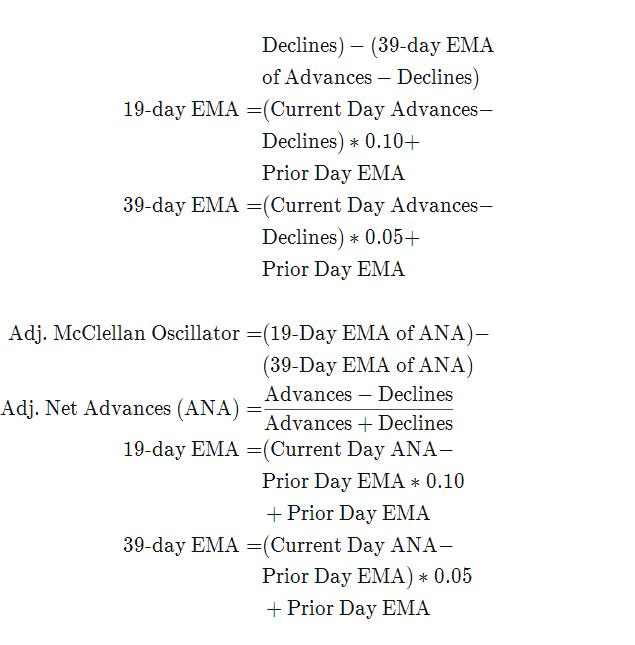Oscillateur McClellan
Qu’est-ce que l’oscillateur McClellan?
L’oscillateur McClellan est un indicateur de l’ étendue du marché basé sur la différence entre le nombre d’émissions en progression et en baisse sur une bourse, telle que la Bourse de New York (NYSE) ou le NASDAQ. L’indicateur est comparé aux indices boursiers liés à l’échange.
L’indicateur est utilisé pour montrer de forts changements de sentiment dans les indices, appelés poussées de largeur. Il aide également à analyser la force d’une tendance d’indice via une divergence ou une confirmation.
Points clés à retenir
- La formule McClellan Oscillator peut être appliquée à n’importe quelle bourse ou groupe d’actions.
- Une lecture au-dessus de zéro permet de confirmer une hausse de l’indice, tandis que des lectures inférieures à zéro confirment une baisse de l’indice.
- Lorsque l’indice augmente mais que l’oscillateur baisse, cela avertit que l’indice pourrait également commencer à baisser. Lorsque l’indice diminue et que l’oscillateur monte, cela indique que l’indice pourrait bientôt commencer à augmenter. C’est ce qu’on appelle la divergence.
- Un changement significatif, comme le déplacement de 100 points ou plus, d’une lecture négative à une lecture positive est appelé une poussée de largeur. Cela peut indiquer qu’un fort renversement de la tendance baissière à la tendance haussière est en cours sur la bourse.
La formule de l’oscillateur McClellan est
Il existe deux formules pour l’oscillateur McClellan. La formule originale, et celle qui ajuste les variations du nombre d’actions cotées en bourse. La formule ajustée permet une meilleure comparaison des valeurs sur des périodes plus longues.

where:EMA=Exponential moving averageAdvances=Number of stocks trading above theirprevious day’s closeDeclines=Number of stocks trading below theirprevious day’s close\begin{aligned} &\textbf{where:} \\ &\text{EMA} = \text{Exponential moving average} \\ &\text{Advances} = \text{Number of stocks trading above their} \\ &\text{previous day’s close} \\ &\text{Declines} = \text{Number of stocks trading below their} \\ &\text{previous day’s close} \\ \end{aligned}where:EMA=Exponential moving averageAdvances=Number of stocks trading above theirprevious day’s closeDeclines=Number of stocks trading below theirprevious day’s close
How to Calculate the McClellan Oscillator
- To get the calculation started, track Advances – Declines on a stock exchange for 19 and 39 days. Calculate a simple average for these, not exponential moving average (EMA).
- Use these simple values as the Prior Day EMA values in the 19- and 39-day EMA formulas.
- Calculate the 19- and 39-day EMAs.
- Calculate the McClellan Oscillator value.
- Now that the value has been calculated, on the next calculation use this value for the Prior Day EMA. Start calculating EMAs for the formula instead of simple averages.
- If using the adjusted formula, the steps are the same, except use ANA instead of using Advances – Declines.
What Does the McClellan Oscillator Tell You?
The McClellan Oscillator is an indicator based on market breadth which technical analysts can use in conjunction with other technical tools to determine the overall health of the stock market and assess the strength of its current trend.
Since the indicator is based on all the stocks in an exchange, it is compared to the price movements of indexes that reflect that exchange, or compared to major indexes such as the S&P 500.
Positive and negative values indicate whether more stocks, on average, are advancing or declining. The indicator is positive when the 19-day EMA is above the 39-day EMA, and negative when the 19-day EMA is below the 39-day EMA.
A positive and rising indicator suggests that stocks on the exchange are being accumulated. A negative and falling indicator signals that stocks are being sold. Typically such action confirms the current trend in the index.
Crossovers from positive to negative, or vice versa, may signal the trend has changed in the index or exchange being tracked. When the indicator makes a large move, typically of 100 points or more, from negative to positive territory, that is called a breadth thrust. It means a large number of stocks moved up after a bearish move. Since the stock market tends to rise over time, this a positive signal and may indicate that a bottom in the index is in and prices are heading higher overall.
When index prices and the indicator are moving in different directions, then the current index trend may lack strength. Bullish divergence occurs when the oscillator is rising while the index is falling. This indicates the index could head higher soon since more stocks are starting to advance.
Bearish divergence is when the index is rising and the indicator is falling. This means fewer stocks are keeping the advance going and prices may start to head lower.
The Difference Between the McClellan Oscillator and McClellan Summation Index?
The McClellan Oscillator was developed by Sherman and Marian McClellan, who also developed the McClellan Summation Index.1 The McClellan Summation Index adds the current day’s McClellan Oscillator to the previous day’s McClellan Summation Index. In other words, the Summation Index is a cumulative measure, whereas the oscillator is not. While the oscillator may be more useful for analyzing shorter-term trends, the Summation Index is more applicable to broader and longer-term price trends.
Limitations of Using the McClellan Oscillator
The indicator tends to produce lots of signals. Breadth thrusts, divergence, and crossovers all occur with some frequency, but not all these signals will result in the price/index moving in the expected direction. The indicator is prone to producing false signals and therefore should be used in conjunction with price action analysis and other technical indicators.
The indicator can also be quite choppy, moving between positive and negative territory rapidly. Such action indicates a choppy market, but this isn’t evident until the indicator has made this whipsaw move a few times.
Study how the indicator acts over extended periods of time and in different market conditions before relying on the indicator for trading purposes.